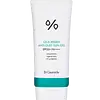What's inside
What's inside
 Key Ingredients
Key Ingredients

 Benefits
Benefits

 Concerns
Concerns

No concerns
 Ingredients Side-by-side
Ingredients Side-by-side

Water
Skin ConditioningDicaprylyl Carbonate
EmollientButylene Glycol
HumectantDibutyl Adipate
EmollientDiethylamino Hydroxybenzoyl Hexyl Benzoate
UV FilterHydrogenated Polyisobutene
Emollient1,2-Hexanediol
Skin ConditioningGlycerin
HumectantNiacinamide
SmoothingEthylhexyl Triazone
UV AbsorberPolyglyceryl-3 Methylglucose Distearate
EmulsifyingSilica
AbrasiveCetearyl Olivate
Polyquaternium-51
Skin ConditioningCetearyl Alcohol
EmollientSorbitan Olivate
EmulsifyingGlyceryl Stearate Se
EmulsifyingMethyl Glucose Sesquistearate
EmollientSorbitan Stearate
EmulsifyingCitrus Aurantium Dulcis Peel Oil
MaskingLavandula Angustifolia Oil
MaskingCentella Asiatica Extract
CleansingDisodium EDTA
Actinidia Arguta Fruit Extract
Skin ConditioningAdenosine
Skin ConditioningAnthemis Nobilis Flower Oil
MaskingNelumbo Nucifera Flower Extract
Skin ConditioningTocopherol
AntioxidantCaprylyl Glycol
EmollientHibiscus Sabdariffa Flower Extract
Skin ConditioningEthylhexylglycerin
Skin ConditioningWater, Dicaprylyl Carbonate, Butylene Glycol, Dibutyl Adipate, Diethylamino Hydroxybenzoyl Hexyl Benzoate, Hydrogenated Polyisobutene, 1,2-Hexanediol, Glycerin, Niacinamide, Ethylhexyl Triazone, Polyglyceryl-3 Methylglucose Distearate, Silica, Cetearyl Olivate, Polyquaternium-51, Cetearyl Alcohol, Sorbitan Olivate, Glyceryl Stearate Se, Methyl Glucose Sesquistearate, Sorbitan Stearate, Citrus Aurantium Dulcis Peel Oil, Lavandula Angustifolia Oil, Centella Asiatica Extract, Disodium EDTA, Actinidia Arguta Fruit Extract, Adenosine, Anthemis Nobilis Flower Oil, Nelumbo Nucifera Flower Extract, Tocopherol, Caprylyl Glycol, Hibiscus Sabdariffa Flower Extract, Ethylhexylglycerin
Water
Skin ConditioningZinc Oxide
Cosmetic ColorantTitanium Dioxide
Cosmetic ColorantIsododecane
EmollientNeopentyl Glycol Diheptanoate
EmollientButylene Glycol
HumectantPropanediol
SolventDioctyldodeceth-5 Lauroyl Glutamate
EmollientAlumina
AbrasiveAmmonium Acryloyldimethyltaurate/Vp Copolymer
Caprylhydroxamic Acid
Glyceryl Stearate
EmollientSteareth-21
CleansingSteareth-2
EmulsifyingPEG-100 Stearate
Phenoxyethanol
PreservativeMethylpropanediol
SolventSimethicone
EmollientMethyl Gluceth-20
HumectantTriethanolamine
BufferingCarbomer
Emulsion StabilisingAscorbyl Tetraisopalmitate
AntioxidantTocopheryl Acetate
AntioxidantXanthan Gum
EmulsifyingSodium Hyaluronate
HumectantSaxifraga Sarmentosa Extract
Skin ConditioningWater, Zinc Oxide, Titanium Dioxide, Isododecane, Neopentyl Glycol Diheptanoate, Butylene Glycol, Propanediol, Dioctyldodeceth-5 Lauroyl Glutamate, Alumina, Ammonium Acryloyldimethyltaurate/Vp Copolymer, Caprylhydroxamic Acid, Glyceryl Stearate, Steareth-21, Steareth-2, PEG-100 Stearate, Phenoxyethanol, Methylpropanediol, Simethicone, Methyl Gluceth-20, Triethanolamine, Carbomer, Ascorbyl Tetraisopalmitate, Tocopheryl Acetate, Xanthan Gum, Sodium Hyaluronate, Saxifraga Sarmentosa Extract
Ingredients Explained
These ingredients are found in both products.
Ingredients higher up in an ingredient list are typically present in a larger amount.
Butylene Glycol (or BG) is used within cosmetic products for a few different reasons:
Overall, Butylene Glycol is a safe and well-rounded ingredient that works well with other ingredients.
Though this ingredient works well with most skin types, some people with sensitive skin may experience a reaction such as allergic rashes, closed comedones, or itchiness.
Learn more about Butylene GlycolWater. It's the most common cosmetic ingredient of all. You'll usually see it at the top of ingredient lists, meaning that it makes up the largest part of the product.
So why is it so popular? Water most often acts as a solvent - this means that it helps dissolve other ingredients into the formulation.
You'll also recognize water as that liquid we all need to stay alive. If you see this, drink a glass of water. Stay hydrated!
Learn more about Water